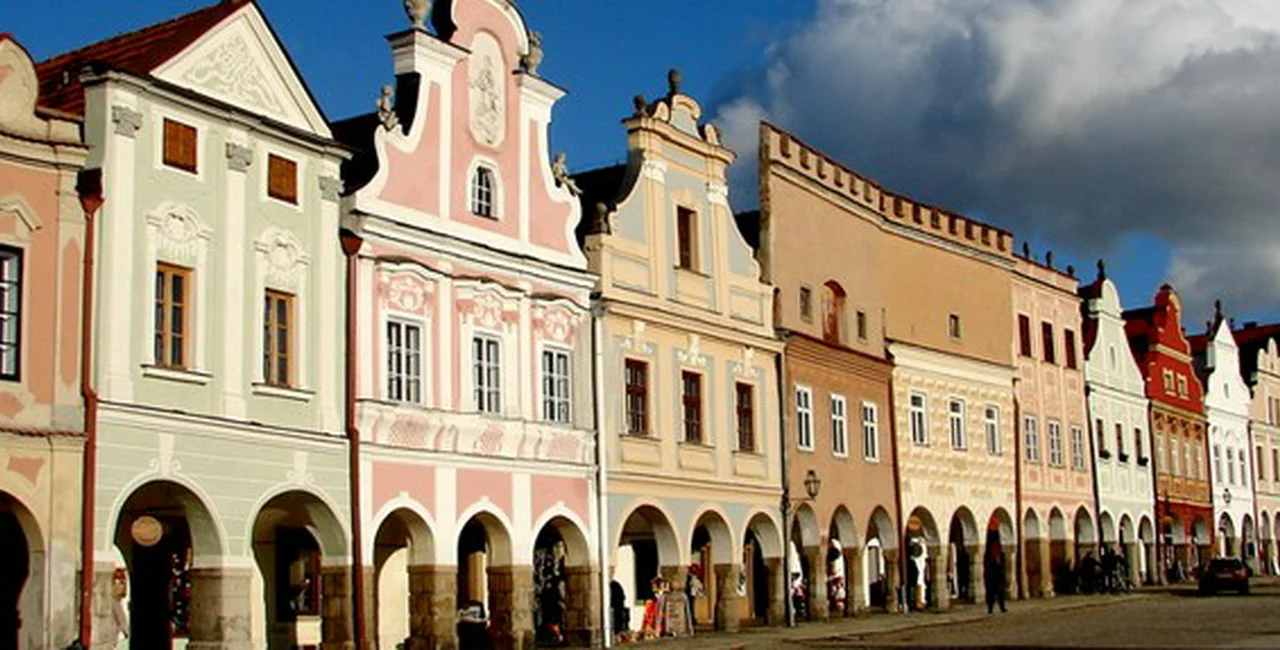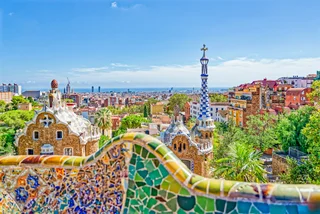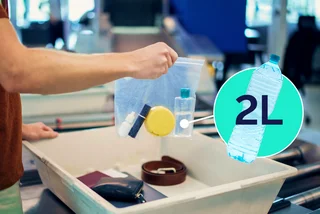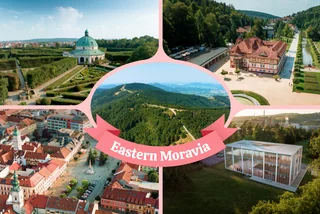If you´ve spent any time visiting historic Czech towns, you´ll begin to see a pattern emerging. At the heart of the town there is a spacious cobbled square. The focal point will usually be a plague column or fountain, or both, surrounded by a clutch of locally significant buildings, such as a town hall, church and a few burgher houses.The small historic town of Telč, in the Bohemian-Moravian Uplands, ticks all of these boxes, and gets a Grade A for its outstanding collection of burgher houses. It can also boast a fine Renaissance château, making Telč one of the architectural highlights of the Czech Republic.
The origins of Telč go back to the Middle Ages, and settlers moved here in the 12th century, creating fishponds and inhabiting the land between them. A castle was built in the 13th century, and Telč received its charter in the mid 1300s. The town prospered, and a market place was established and burgher houses built.
In 1530 a dramatic fire ravaged the town, destroying the houses on the marketplace and damaging the castle. The current marketplace is the result of the rebuilding work after the fire, and paradoxically this catastrophe has resulted in one of the most complete and beautiful urban landscapes anywhere in Europe.
Today, there is a strong sense of history and a link with the past in Telč: the center has changed very little since the great fire; indeed, it would not be an exaggeration to say that the fire was the last major event in the town. Telč is a popular tourist destination in the summer months, but unlike other historic towns, such as Český Krumlov, it is not dedicated to wringing every last crown from visitors. Telč is a living town, rather than just another museum piece.
This is evident as you reach the Upper Gate (Horní brána), on the eastern edge of the historic town, where there is a mix of old and new buildings. Once through the gate, you go back in time, and as you walk along Palackého Street, one of Europe´s most beautiful squares, náměstí Zachariáše z Hradce (the “Square”) reveals itself. Unlike many other market squares in the Czech Republic, is is not so much a square as a rectangle, or rather a very long, stretched ‘A´. The irregularly-shaped space and the distinctly uneven cobbled surface only heighten the dramatic visual effect.
A touch of greenery at the eastern end sets off the ornate 17th-century Marian column and one of the hexagonal fountains. They are faced on the north, south and east sides by Renaissance and Baroque buildings decked out in a variety of colors, with two-story arcaded burgher houses play the leading role in the group.
The much longer north and south sides are particularly striking; the houses are lined up like a row of over the top cakes in a cukrárna, waiting to be picked. No two are alike, as if the builders were asked to try and come up with as many decorative motifs and variations on a theme as they could. One of the most eye-catching features is the incredible assortment of gables on display. Simple triangles mutate into elaborate confections, such as those of numbers 57 and 59. Other facades culminate in what appear to be battlements, such as the Town Hall (Radnice) at number 10.
If you take a closer look from across the square you will see that it too has a pointed roof and that its crenellations are a mere illusion. This is rather fitting in a space that one travel writer described as being “so preposterously picturesque that you half expect one [gable] to tip over in the wind and a man to scream ‘CUT!´”[1] The arcades running around the square, the relatively unified heights of the buildings and the repetition of gables facing the street harmonize all the different aspects.
Each building is a photographer´s dream. While it´s very hard to pick favorites, the most notable houses include the Town Hall, number 15, with sgraffito decoration, and an oriel window tucked into a corner, and number 61, also covered in sgraffito and with a distinctive swallow-tale gable.
The château, which replaced an earlier Gothic castle, rounds off the western end of náměstí Zacharíaše z Hradce, at the tip of the ‘A´. Although an extensive complex, it harmonizes well with the square, and its interiors have been well preserved. They can only be seen on guided tours. Tour A, taking visitors round the Renaissance chambers, is probably the more interesting while Tour B concentrates on the residential rooms of the Podstatský family, the last owners of the château.
The château was owned by the Lords of Hradec, and was remodeled from 1550 by Zacharíáš z Hradce, who was also responsible for much of the château at nearby Jindřichův Hradec. Zachariáš was an admirer of all things Italian, which is clearly in evidence in the Renaissance architecture. It can be seen to best effect on Tour A, whose highlights include the Golden Hall, a long room with a magnificent coffered ceiling; the Knights Hall and the Dining Hall, featuring a beautiful doorway and depictions of the Seven Deadly Sins. Visitors can also see the Treasury, with walls covered in illusionist painting, and the Gothic Ceremonial Hall, with a painted vaulted ceiling. Not included in either of the tours is the lavish chapel housing the tombs of Zachariáš and his wife Kateřina of Waldstein, notable for its stucco work buzzing with details and ceiling reliefs.
The east wing of the château, adjacent to the tranquil courtyard and opposite the chapel, is home to the Galerie Jana Zrzavého (Jan Zrzavý Gallery). It houses a collection of paintings by the eponymous artist (1890- 1977), a native of the area and noted for his dreamy landscapes. The château also houses the Telč branch of the Muzeum Vysočiny, dedicated to the life and times of the area. Its exhibits include a model of the town and a large nativity scene (Betlém).
Immediately next door to the château is the parish Church of St James, (kostel sv. Jakuba) and next to that is the bulky former Jesuit college. The parish church has a simple Gothic interior and is worth a look if open. The tower is open to the public. Near the entrance are memorials to those who fell in World War One and to the victims of World War Two, a reminder of how modern history has had an impact on a rural backwater like Telč. Although not explicitly stated, most of the World War Two victims were Jewish.
Other Sights
Back on the square, number 122 is home to the small Městská galerie hasičský dům, a gallery run by the town council. The gaunt Romanesque tower of the Holy Ghost Church (věž sv. Ducha), on Palackého Street, is open to the public and affords great views over the square and the surrounding countryside. If you have time to spare, it´s worth wandering beyond the confines of the center to get a better view of the context of Telč and appreciate its unusual setting, squeezed between fishponds. U masných kramů and then Židovská Street lead south from the square to a bridge over the Štěpnický rybník (fishpond), from where there are excellent views. Another path leads along the Staroměstský rýbnik to the Church of the Mother of God (kostel Matky boží), also a photogenic spot.

Telč’s fishponds
Getting There
If you´re travelling from Prague or Brno, the best way to reach Telč is by road, via Jihlava. Buses run daily from the Florenc station or Roztyly. The journey (from Roztyly) takes 2 3/4 hours, with a break in Jihlava. Direct buses also run from Brno, and there are also connections with Česke Budějovice (via Jindřichův Hradec and Třeboň). The rail connection is feasible only if you have lots of time to spare: local trains run to and from Jihlava, and the journey takes just over an hour.
Further On
Telč is also a good base to explore other attractions in South Moravia, and is within easy reach of South Bohemia. Some would say that Slavonice, a similar town, around 20 miles south of Telč, is even more beautiful. It is notable for, among other things its abundance of sgraffito. Due to sparse transport connections and its isolated location near the Austrian border, Slavonice is not the easiest place to reach, but if you have the time, it´s worth making the most of a visit to Telč to see to its southern twin. In neighboring South Bohemia there are bus connections with Třeboň and Jindřichův Hradec; like Telč, small towns each with beautifully preserved historic cores and extensive châteaux.
Tourist Information
náměstí Zachariáše z Hradce, 588 56 Telč
Phone: 567 112 407 or 567 112 408
E-mail: info@telc-etc.cz, www.telc-etc.cz
[1] Kadri, Sadat (1993) Prague, 3rd Edition, London: Cadogan, p. 373












 Reading time: 7 minutes
Reading time: 7 minutes 

















